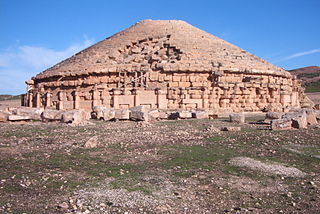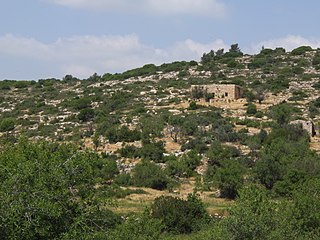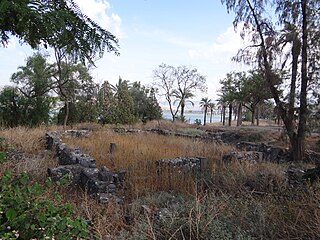
The Levant is an approximate historical geographical term referring to a large area in the Eastern Mediterranean region of West Asia. In its narrowest sense, which is in use today in archaeology and other cultural contexts, it is equivalent to Cyprus and a stretch of land bordering the Mediterranean Sea in western Asia: i.e. the historical region of Syria, which includes present-day Israel, Jordan, Lebanon, Syria, the Palestinian territories and most of Turkey southwest of the middle Euphrates. Its overwhelming characteristic is that it represents the land bridge between Africa and Eurasia. In its widest historical sense, the Levant included all of the Eastern Mediterranean with its islands; that is, it included all of the countries along the Eastern Mediterranean shores, extending from Greece to Cyrenaica in eastern Libya.


In archaeology, a tell or tel, is an artificial topographical feature, a species of mound consisting of the accumulated and stratified debris of a succession of consecutive settlements at the same site, the refuse of generations of people who built and inhabited them, and of natural sediment.

Cana of Galilee is the location of the Wedding at Cana, at which the miracle of turning water into wine took place in the Gospel of John.

Qal'at Bani Hammad, also known as Qal'a Bani Hammad or Qal'at of the Beni Hammad, is a fortified palatine city in Algeria. Now in ruins, in the 11th century, it served as the first capital of the Hammadid dynasty. It is in the Hodna Mountains northeast of M'Sila, at an elevation of 1,418 metres (4,652 ft), and receives abundant water from the surrounding mountains. The site is near the town of Maadid, about 225 kilometres (140 mi) southeast of Algiers, in the Maghreb.

Umm ar-Rasas, ancient name: Kastron Mefa'a, is located 30 km southeast of Madaba in the Amman Governorate in central Jordan. It was once accessible by branches of the King's Highway, and is situated in the semi-arid steppe region of the Jordanian Desert. The site has been associated with the biblical settlement of Mephaat mentioned in the Book of Jeremiah. The Roman military utilized the site as a strategic garrison, but it was later converted and inhabited by Christian and Islamic communities. In 2004, the site was inscribed as a UNESCO World Heritage Site, and is valued by archaeologists for its extensive ruins dating to the Roman, Byzantine, and early Muslim periods. The Franciscan academic society in Jerusalem, Studium Biblicum Franciscanum (SBF), carried out excavations at the north end of the site in 1986, but much of the area remains buried under debris.
The Umayyad desert castles, of which the desert castles of Jordan represent a prominent part, are fortified palaces or castles in what was the then Umayyad province of Bilad al-Sham. Most Umayyad "desert castles" are scattered over the semi-arid regions of north-eastern Jordan, with several more in Syria, Israel and the West Bank (Palestine).

Khirbet Kerak or Beth Yerah is a tell located on the southern shore of the Sea of Galilee in modern-day Israel. The tell spans an area of over 50 acres—one of the largest in the Levant—and contains remains dating from the Early Bronze Age and from the Persian period through to the Early Islamic period.

Madghacen, also spelled Medracen or Medghassen or Medrassen or Madghis is a royal mausoleum-temple of the Berber Numidian Kings which stands near Batna city in Aurasius Mons in Numidia, Algeria.

Khirbat al-Tannur, also known as Allar al-Sifla, was a Palestinian Arab hamlet in the Jerusalem Subdistrict, near Allar. It was depopulated during the 1948 Arab–Israeli War on October 21, 1948, under Operation Ha-Har. It was located 18.5 km west of Jerusalem.

Al-Sinnabra or Sinn en-Nabra, is the Arabic place name for a historic site on the southern shore of the Sea of Galilee in modern-day Israel. The ancient site lay on a spur from the hills that close the southern end of the Sea of Galilee, next to which towards its south being the tell, Khirbet Kerak or Bet Yerah, one of the largest in the Levant, spanning an area of over 50 acres. Bet Yerah was the Hellenistic era twin city of Sennabris, as al-Sinnabra was known in Classical antiquity, and its remains are located at the same tell.

Beidha, also sometimes Bayda, is a major Neolithic archaeological site a few kilometres north of Petra near Siq al-Barid in Jordan. It is included in Petra's inscription as a UNESCO World Heritage Site.
The Directorate General of Antiquities is a Lebanese government directorate, technical unit of the Ministry of Culture and is responsible for the protection, promotion and excavation activities in all sites of national heritage in Lebanon. Sarkis Khoury is the Director General with other staff including Joumana Nakhle and Laure Salloum.
Khirbet ed-Dharih is an archaeological site including a Nabataean settlement and religious sanctuary outside of Petra, Jordan. The site is located in southern Jordan, in the city of Tafileh, 100 km north of Petra. The earliest signs of human habitation at the site are from the Neolithic period and more specifically the Pre-Pottery Neolithic period circa 4000-6000 BCE.
Lorenzo Nigro is an Italian archaeologist, novelist and water-colorist. He is Full Professor of Near Eastern Archaeology in the Faculty of Letters and Philosophy at Sapienza University of Rome. He directs four main archaeological expeditions at Jericho in Palestine, with the Ministry of Tourism and Antiquities, at the Early Bronze Age fortified city, previously unknown, of Khirbet al-Batrawy in the Hashemite Kingdom of Jordan, and at Motya, a Phoenician city in Western Sicily, and he is co-director of the Institut National du Patrimoine-Sapienza University of Rome Expedition to Carthage. Since 2015 he started the archaeological exploration, again in cooperation with the Palestinian Ministry of Tourism and Antiquities, in the necropolis of Bethlehem and at the site of Tell es-Sheikh Abu Zarad, ancient Tappuah. In all these excavations it has been protagonist of several important discoveries, from the reconstruction of the Bronze Age City at Jericho, to the Temple of the Kothon at Motya, to the entire unknown city of Batrawy with its magnificent fortifications, the Palace of the Copper Axes, and the Broad Room temple. At Motya it has uncovered at least four temples and detailed a prehistoric stratigraphy at the foot of the acropolis showing that the island in Sicily was occupied and known to Mediterranean sailormen since the beginning of the 2nd Millennium BC.

Khirbet al-Mukhayyat, also commonly known as the town of Nebo, is a village in Madaba Governorate in Jordan. The village is about 3.5 km from Mount Nebo, also known as Siyagha. Many Byzantine churches were found in the village, including the Church of Saint Lot and Saint Procopius, the church of St. George, and the al-Kaniseh Monastery located a short distance down in a valley below the hill. The town also contains material culture from a wide range of phases from the Chalcolithic to the Ottoman period including several Hellenistic features, an Iron Age fort, and a number of caves, tombs, cisterns and agricultural infrastructure.

Nabatean architecture refers to the building traditions of the Nabateans, an ancient Arab people who inhabited northern Arabia and the southern Levant. Their settlements—most prominently the assumed capital city of Raqmu —gave the name Nabatene to the Arabian borderland that stretched from the Euphrates to the Red Sea. Their architectural style is notable for its temples and tombs, most famously the ones found in Petra. The style appears to be a mix of Mesopotamian, Phoenician and Hellenistic influences modified to suit the Arab architectural taste. Petra, the capital of the kingdom of Nabatea, is as famous now as it was in the antiquity for its remarkable rock-cut tombs and temples. Most architectural Nabatean remains, dating from the 1st century BC to the 2nd century AD, are highly visible and well-preserved, with over 500 monuments in Petra, in modern-day Jordan, and 110 well preserved tombs set in the desert landscape of Hegra, now in modern-day Saudi Arabia. Much of the surviving architecture was carved out of rock cliffs, hence the columns do not actually support anything but are used for purely ornamental purposes. In addition to the most famous sites in Petra, there are also Nabatean complexes at Obodas (Avdat) and residential complexes at Mampsis (Kurnub) and a religious site of et-Tannur.
The Nabataean religion was a form of Arab polytheism practiced in Nabataea, an ancient Arab nation which was well settled by the third century BCE and lasted until the Roman annexation in 106 CE. The Nabateans were polytheistic and worshipped a wide variety of local gods as well as Baalshamin, Isis, and Greco-Roman gods such as Tyche and Dionysus. They worshipped their gods at temples, high places, and betyls. They were mostly aniconic and preferred to decorate their sacred places with geometric designs. Much knowledge of the Nabataeans’ grave goods has been lost due to extensive looting throughout history. They made sacrifices to their gods, performed other rituals and believed in an afterlife.

Khirbet et-Tannur is an ancient Nabataean temple situated on top of Jebel Tannur, in today's Jordan. Based on the cults statues iconography, whether the temple was dedicated to the fertility goddess Atargatis and Zeus-Hadad, or perhaps other gods of their own in that form is not yet certain. The only inscription which mentioned a deity was in reference to the Edomite god Qos, who was the equivalent of the Arab god Quzah, the god of the sky.

Judith Sheila McKenzie was an Australian archaeologist whose work primarily focused on the architecture of the ancient Middle East. At the time of her death, McKenzie was Associate Professor of Late Antique Egypt and the Holy Land at the University of Oxford and Director of the Manar al-Athar project, an open-access image archive of the Middle East. McKenzie was known in particular for her work on the architecture of Petra and Alexandria, having published lengthy monographs on each.















